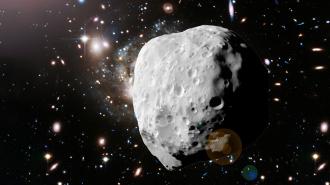The China National Space Administration (CNSA) will attempt to redirect the orbit of an asteroid by slamming a spacecraft into it, Wu Yanhua, the agency’s deputy director, told China Central Television (CCTV).
The mission is one part of CNSA’s new planetary defense strategy, designed to preempt a potentially devastating asteroid impact in the future.
Space threats: After our solar system’s planets were formed, millions of rocky objects were left over, like screws following the assembly of an Ikea table. The largest of those objects are asteroids, and they now orbit the sun along with the planets.
Most asteroids are far away, but some do get close to our planet, and occasionally, they slam into its surface. If a large enough asteroid were to strike Earth, like the one that killed the dinosaurs, it could theoretically wipe out humanity.
Planetary defense: In the hope of preventing such a rare but catastrophic scenario, some space agencies have planetary defense offices that detect and track nearby asteroids, keeping an eye out for any that might be dangerous. They also strategize and test ways to avoid future asteroid impacts.
China is now taking a more active interest in planetary defense.
If a large enough asteroid were to strike Earth, it could theoretically wipe out humanity.
In October 2021, the nation held its first Planetary Defense Conference, and in January 2022, it released a white paper saying it would “increase the capacity of near-earth object monitoring, cataloguing, early warning, and response” in the next five years.
Wu has now told CCTV that CNSA plans to launch a mission in 2025 or 2026 to study an asteroid up close. It will then impact the space rock to attempt to alter its orbit, the idea being that we might be able to use this method to redirect an asteroid headed toward Earth one day.
Wu did not mention if the agency had already chosen a target for the mission.
Throw a DART: The idea of slamming something into an asteroid sounds pretty radical, but CNSA isn’t the only agency exploring this planetary defense strategy.
In November 2021, NASA launched the Double Asteroid Redirection Test (DART), a mission to crash a 1,340-pound space probe into Dimorphos, one part of a double asteroid system called Didymos.
These redirection tests can let us know what might happen if we try to alter a threatening asteroid’s trajectory in the future.
The impact is expected to reduce Dimorphos’s orbit around Didymos, the bigger asteroid, by about 10 minutes, from about 11 hours 45 minutes currently.
But the specific outcome could vary quite a bit, depending on how the rock responds to being hit, so the experiment will provide crucial data about what kind of response we’d get if we ever needed to alter an asteroid’s trajectory toward Earth.
The DART impact is expected to occur in September 2022, and in 2027, an ESA spacecraft — Hera — will visit the system to study the collision’s aftermath in detail.
Looking ahead: Hopefully, both NASA and CNSA will find that they can reliably redirect an asteroid, as that would be incredibly reassuring for all of us, but even if this approach to planetary defense isn’t viable, others have floated ideas that might be.
Instead of slamming something into an asteroid, we might want to use a nuclear bomb to blow it up, for example, or fire arrays of penetrators rods into space to slice it up — turning a big, humanity-threatening space rock into many small, harmless ones.
We’d love to hear from you! If you have a comment about this article or if you have a tip for a future Freethink story, please email us at tips@freethink.com.






